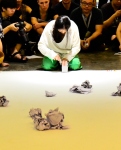Astral Travel and the Astral Plane
Laura Hamilton
Source : http://www.psychicsuniverse.com
Imagine traveling the globe or to other worlds and dimensions without leaving the comfort of your chair. Believe it or not this can be done through astral travel. Also known as astral projection, this is essentially an out of body experience or OBE. Your consciousness moves outside of your body and can freely travel around practically anywhere.
Astral travel can be a wonderful and enlightening experience. It will provide you with an entirely new perspective!
The Astral Plane
When people talk about astral travel or astral projection, questions often come up about visiting friends and spying on lovers to see if they are cheating. While astral travel does include earth-based travel, it is quite different. You can still see people and even spy on them, but you will find once you are out of body, your priorities will change. Spying probably won’t seem that interesting anymore.
So what is the astral plane like? Well, it’s not just one plane but comprised of many planes or layers. There are numerous dimensions on the astral with various frequencies and energies. There are places where angels and spirits dwell as well as settings with more nefarious types of beings. When starting out with astral travel, many people stay on the earthly or prime material plane. This is where you can float above your house, check out the neighborhood and even play tricks on the family pet.
As you become more adept with astral projection, you might begin to explore different dimensions. The astral plane can be very busy and interesting. You will find that the laws of physics do not apply here as they do on earth. You will float, fly and be whisked about instantaneously.
Not only is there a difference in physical laws, but spiritual ones as well. Karmic laws and the Law of Attraction work instantly. While on the earth plane it takes a while for thoughts to physically manifest, on the astral things happen immediately. So it is extremely important to be mindful of your thoughts, actions and attitudes while on the astral. Negative thoughts and deeds will come back at you like a boomerang to the head, while good and loving actions will be rewarded quickly.
The astral planes also contain many souls who are passing by on their way to the heavenly realms. Many unfortunate beings even get stuck here along the way. Some may be lost or confused, while others get caught up in the pleasures they find while hanging out on the astral.
Learning Astral Projection
Learning to have an out of body experience takes some practice, but we all have the ability to do it. Some find it very easy to do, while others find it challenging. The keys are to keep practicing, be confident and psychically protect yourself.
There are a variety of techniques available to assist you with astral travel. Some involve meditation and relaxation while others use binaural beats to get your brain attuned to frequencies to help you leave your body.
There are four simple steps you can follow when practicing astral travel.
1. The first is relaxation.
Ensure that you have a quiet place where you won’t be disturbed. Make sure you are in a positive and proper frame of mind. Psychically protect yourself. Then relax almost to the point of falling asleep.
2. Get to the hypnagogic state.
This is where your body is asleep but your mind is awake, much like lucid dreaming. You may feel sleep paralysis, where your body can’t move. Your five senses will dull and you may hear buzzing or humming noises. This means you are close.
3. Separate from your body.
This is where your consciousness exits from your physical body. You can put your focus above you or across the room. You may also try pulling yourself up and out of your body by grabbing an imaginary rope. Eventually you will be above or beside your body seeing yourself sleeping.
4. Explore.
Stabilize your awareness and explore the world around you. You can’t get lost and you will always come back to your body.
Astral travel can be a wonderful and enlightening experience. It will provide you with an entirely new perspective!






